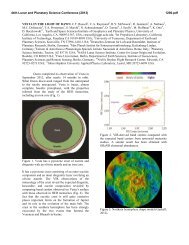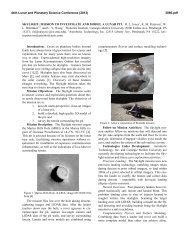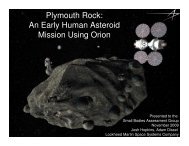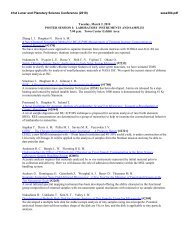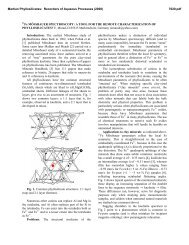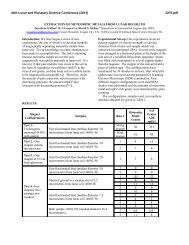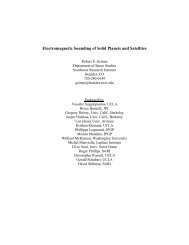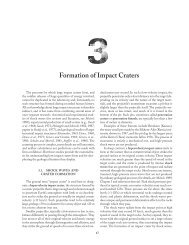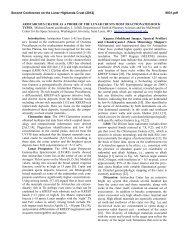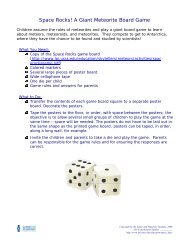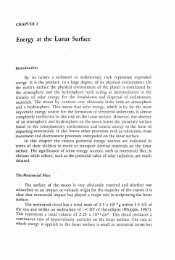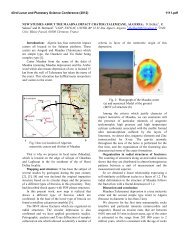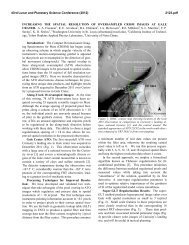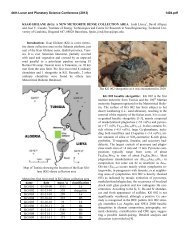Jupiter System Observer Mission Study: Final Report - Lunar and ...
Jupiter System Observer Mission Study: Final Report - Lunar and ...
Jupiter System Observer Mission Study: Final Report - Lunar and ...
Create successful ePaper yourself
Turn your PDF publications into a flip-book with our unique Google optimized e-Paper software.
2007 JUPITER SYSTEM OBSERVER MISSION STUDY: FINAL REPORT 01 NOVEMBER 2007<br />
Task Order #NMO710851 SECTION 3—MISSION ARCHITECTURE ASSESSMENT<br />
also challenging, since the water <strong>and</strong><br />
especially ammonia overhead absorb radio<br />
signals. Given the capabilities of radio systems<br />
available for Galileo-like <strong>Jupiter</strong> probe<br />
applications, at the “sweet spot” frequencies<br />
around 1.35 to 1.4 GHz, <strong>and</strong> given 5 times<br />
solar oxygen <strong>and</strong> nitrogen abundances, the<br />
deepest a probe could expect to reach <strong>and</strong> still<br />
transmit a useful signal is less than 70 bars. If<br />
the abundances are 10 times solar, the limiting<br />
depth is much shallower. The primary problem<br />
is that a Galileo-like, single-element probe’s<br />
radio system must address simultaneously the<br />
problems of atmospheric attenuation <strong>and</strong><br />
attenuation due to the large distance from the<br />
probe to the receiving asset. This problem<br />
might be overcome by a two-element probe<br />
that maintains one element higher in the<br />
atmosphere, where overhead absorption is<br />
much less severe, <strong>and</strong> a deep element that<br />
relays its data to the shallow element only a<br />
few hundred km away. The deep-to-shallow<br />
link is relieved of the need to fight the large<br />
distance to the ultimate receiving asset, <strong>and</strong> the<br />
shallow-to-ultimate-receiver link is relieved of<br />
the atmospheric attenuation problem. Such<br />
probe architectures have not yet been seriously<br />
studied for a flight project so their TRL is low,<br />
<strong>and</strong> the need to use them undoubtedly adds to<br />
the estimated probe system mass <strong>and</strong> adds risk<br />
to the mission.<br />
The desire to follow-up on the Galileo<br />
probe results is very compelling. The science<br />
to be returned by a potential JSO deep probe<br />
must be assessed in light of a number of<br />
factors. First, the science questions to be<br />
addressed by the probe must be well defined.<br />
There is currently debate in the <strong>Jupiter</strong><br />
atmospheric science community regarding the<br />
depth (100 bars or possibly more) needed to<br />
achieve a conclusive <strong>and</strong> robust water<br />
measurement. The range of depths has<br />
significant implications as to how to design the<br />
probe. Second, <strong>and</strong> linked to the first issue, the<br />
Juno <strong>Mission</strong> will just be starting to return<br />
critical water abundance data needed for<br />
design at the time when the manufacture of the<br />
JSO probe should be nearly complete. <strong>Final</strong>ly,<br />
the JSO mass available for a probe is sufficient<br />
for the inclusion of a single probe. Since<br />
targeting a probe at <strong>Jupiter</strong> must be<br />
accomplished well before JOI, the specific<br />
atmospheric environment that it will enter<br />
3-7<br />
cannot be predicted. Like the Galileo probe,<br />
there is a risk of entering an anomalous region<br />
<strong>and</strong> compromising the science return.<br />
Therefore, the design of the probe needs to<br />
have a better underst<strong>and</strong>ing of the science<br />
requirements on depth along with the need for<br />
Juno results for design constrains.<br />
3.4.4 Selection Criteria<br />
The selection criteria to arrive at the final<br />
two architectures were based on science, cost,<br />
risk, <strong>and</strong> other intangibles.<br />
Table 3.4-2 shows the relative qualitative<br />
scoring of these factors for the four<br />
architectures using a star rating scale, 4 being<br />
the highest.<br />
Table 3.4-2. Comparative Rating of the<br />
Intermediate Architectures<br />
Science<br />
Science<br />
Cost<br />
Cost<br />
Risk<br />
Risk<br />
Intangibles<br />
Intangibles<br />
<strong>Mission</strong><br />
<strong>Mission</strong><br />
Development<br />
Development<br />
Technology<br />
Technology<br />
Option Option 1<br />
1<br />
<br />
<br />
<br />
<br />
<br />
19<br />
19<br />
Option Option 2<br />
2<br />
<br />
<br />
<br />
<br />
<br />
20<br />
20<br />
Option Option 3<br />
3<br />
<br />
<br />
<br />
<br />
<br />
<br />
17<br />
17<br />
Option Option 4<br />
4<br />
<br />
<br />
<br />
<br />
<br />
<br />
The science merit was evaluated as<br />
described in §3.3, 3.4.3, 3.4.4, <strong>and</strong> is shown in<br />
Figure 3.3-1.<br />
The cost rating is based on the relative cost<br />
comparison from §3.4.1.<br />
Risk ratings are separated into 3 areas.<br />
<strong>Mission</strong> risk is associated with potential<br />
operations failure due to system or mission<br />
operations complexity, or operating in an<br />
unknown environment. Based on the<br />
discussion of the deep probe option in §3.4.3,<br />
it was given a 2-star rating compared to the<br />
other architectures. Development risk is<br />
associated with complexity of interfaces <strong>and</strong><br />
number of elements that are required for<br />
integration <strong>and</strong> test. Architecture 1 is the<br />
simplest. Architecture 2 is more risky than 1<br />
because of the larger suite of instrumentation.<br />
Architecture 3 is more risky because of the<br />
large optics <strong>and</strong> potential shared focal plane of<br />
multiple instruments. Architecture 4 is more<br />
risky with the addition of the deep probe.<br />
Architectures 1 <strong>and</strong> 2 are similar in technology<br />
readiness with concern mainly in the re-design<br />
of rad-hard electronics <strong>and</strong> sensors.<br />
Architecture 3, with optics equal or better than<br />
12<br />
12



